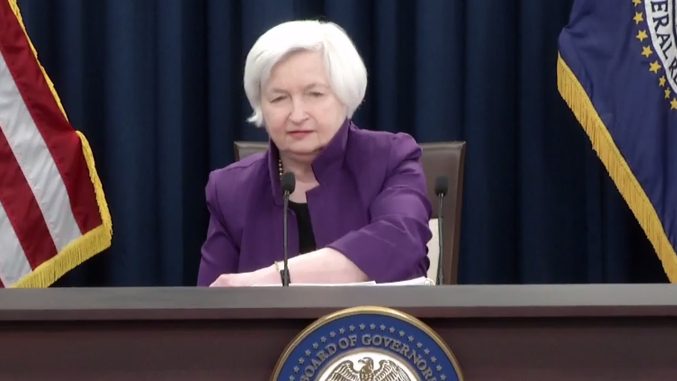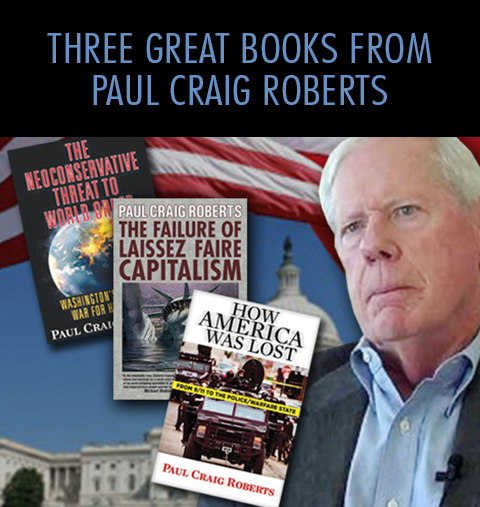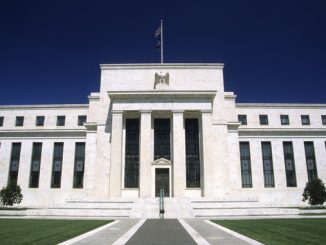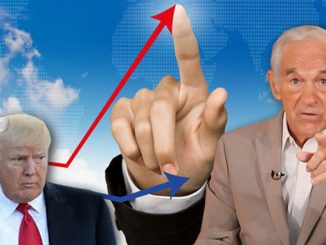
The U.S. central bank, the Federal Reserve, is once again moving to prop up the “too-big-to-fail” banks by playing games with interest rates, and the financial media will not explain this, let alone cover it, so that average Americans can understand what is being done to the U.S. economy and them.
By Paul Craig Roberts
Several years ago when the Federal Reserve had its Fed funds rate at zero to 25 basis points (one-quarter of 1% to 0.25%), there was a great deal of talk, somehow presented as urgent, whether the Federal Reserve would raise interest rates.
Russian news agency RT recently asked me if the Fed was going to raise interest rates. I answered that the purpose of low interest rates was to restore the solvency of the balance sheets of the “banks too big to fail” by raising debt prices. The lower the interest rate, the higher the prices of debt instruments. The Fed drives bond prices up by purchasing bonds, and the Fed raises interest rates by selling bonds, or by purchasing fewer of them than previously.
I told RT that a real increase in interest rates would undercut the Fed’s policy of rescuing the balance sheets of the big banks whose balance sheets were loaded up with bad debt that desperately needed a rise in debt prices for the banks to remain solvent.
When shortly thereafter the Fed raised the overnight funds rate, it blew my credibility with RT. RT did not understand that real interest rates had not increased. Indeed, two days after the “rate increase” the nominal interest rate had not changed. It was still 18 basis points. The announced rate had gone from the old range of zero to 25 basis points to a new range of 25 basis points to 50 basis points. The former max was the current minimum.
Bug Out While You Still Can! Learn More…
Moreover, over the long time period in which there was such well marketed concern over whether such an inconsequential interest rate rise would occur, inflation had risen, making the real interest rate negative well below the 18 basis points official interest rate. By the time the Fed raised the nominal rate, the real rate was already more negative. Thus, there was no rise in real interest rates.
The financial press did not explain this, either from incompetence or collusion. RT accepted the fake news as reality and wrote off my credibility. I am often interviewed by RT, but no longer on economic matters, about which I know the most.
A couple of days ago, after a long period of waiting for another interest rate rise, an announcement from the Fed, amidst further indication of U.S. economic decline, announced another 25 basis point increase in the target range for the Fed funds rate.
Inflation aside, in fact interest rates declined, as my sometime co-author Dave Kranzler reports: Despite this publicized “rise” of the Fed funds rate, the 10-year interest rate on treasuries “has declined 30 basis points this year. Thus for certain borrowers, the Fed has effectively lowered the cost of borrowing.”
Kranzler goes on to point out that “the spread between the 30-day treasury bill and the 10-year treasury has declined this year from 193 basis points to 125 basis points—a 68 basis point drop in the cost of funding for borrowers who have access to the highly engineered derivative products that enable these borrowers to take advantage of the shape of the yield curve in order to lower their cost of borrowing.”
Kranzler provides a chart that shows that the spread between the 30-day treasury bill and the 10-year treasury bond is narrowing. As the short-term rate rises, the long-term rate is falling, and the spread between the long and short rate has declined 68 basis points from almost two percentage points to one and one-quarter percentage point.
Clearly, this is not a rise in interest rates.
Clearly also, a rise in the Fed funds rate no longer signals a rise in all interest rates.
Why is the Fed raising short rates when the long rates are falling?
Why do “democratic Western democracies” have central banks that do nothing except protect big banks at the expense of the people?
How long will the insouciant peoples of the West continue to conspire in their own demise?
Paul Craig Roberts was assistant secretary of the Treasury for Economic Policy and associate editor of The Wall Street Journal. He was columnist for BusinessWeek, Scripps Howard News Service, and Creators Syndicate. He has held many university appointments. His Internet columns have attracted a worldwide following. Roberts’s latest books are How AMERICA Was LOST: From 9/11 to the Police/Warfare State and The NEOCONSERVATIVE THREAT to WORLD ORDER: Washington’s Perilous War for Hegemony.






people only want to complain
http://freedomnews.today/
So long as the common people have their bread and circuses, there will be no effective call for real change.